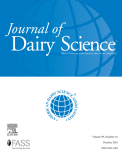Journal of Dairy Science, 99 (2016) 8070–8080
In this study, we assessed the potential as silage additive of a bacteriocin produced by Pediococcus acidilactici Northern Regional Research Laboratory (NRRL) B-5627 (pediocin SA-1). Maize was inoculated either with a bacterial starter alone (I) or in combination with the bacteriocin (IP), and untreated silage served as control. We monitored the products of fermentation (ethanol, and lactic and acetic acids), the microbial population, and the presence of the indicator strain Listeria monocytogenes Colección Española de Cultivos Tipo (CECT) 4032 (1 × 105 cfu/g) after 1, 2, 5, 8, 16, and 30 d of ensiling. Our results indicated antilisterial activity of the bacteriocin, anticipating the disappearance of L. monocytogenes in IP compared with I and control silages. The PCR-denaturing gradient gel electrophoresis analysis revealed the addition of the bacteriocin did not affect the bacterial communities of the spontaneous fermentation, and the inoculant-containing bacteria (Lactobacillus plantarum, Lactobacillus buchneri, and Enterococcus faecium) were found in addition to the bacterial communities of untreated maize silages in I and IP silages. Both treatments increased the concentration of antimicrobial compounds (acetic acid, ethanol, and 1,2-propanodiol) and led to lower residual sugar contents compared with the control, which would provide enhanced aerobic stability. The fact that the identified species L. plantarum, L. buchneri, and E. faecium produce some of these inhibitory compounds, together with their persistence throughout the 30 d of fermentation, suggest these bacteria could actively participate in the ensiling process. According to these results, pediocin SA-1 could be used as an additive to control the presence of L. monocytogenes in maize silages selectively, while improving their fermentative quality and eventually their aerobic stability.

